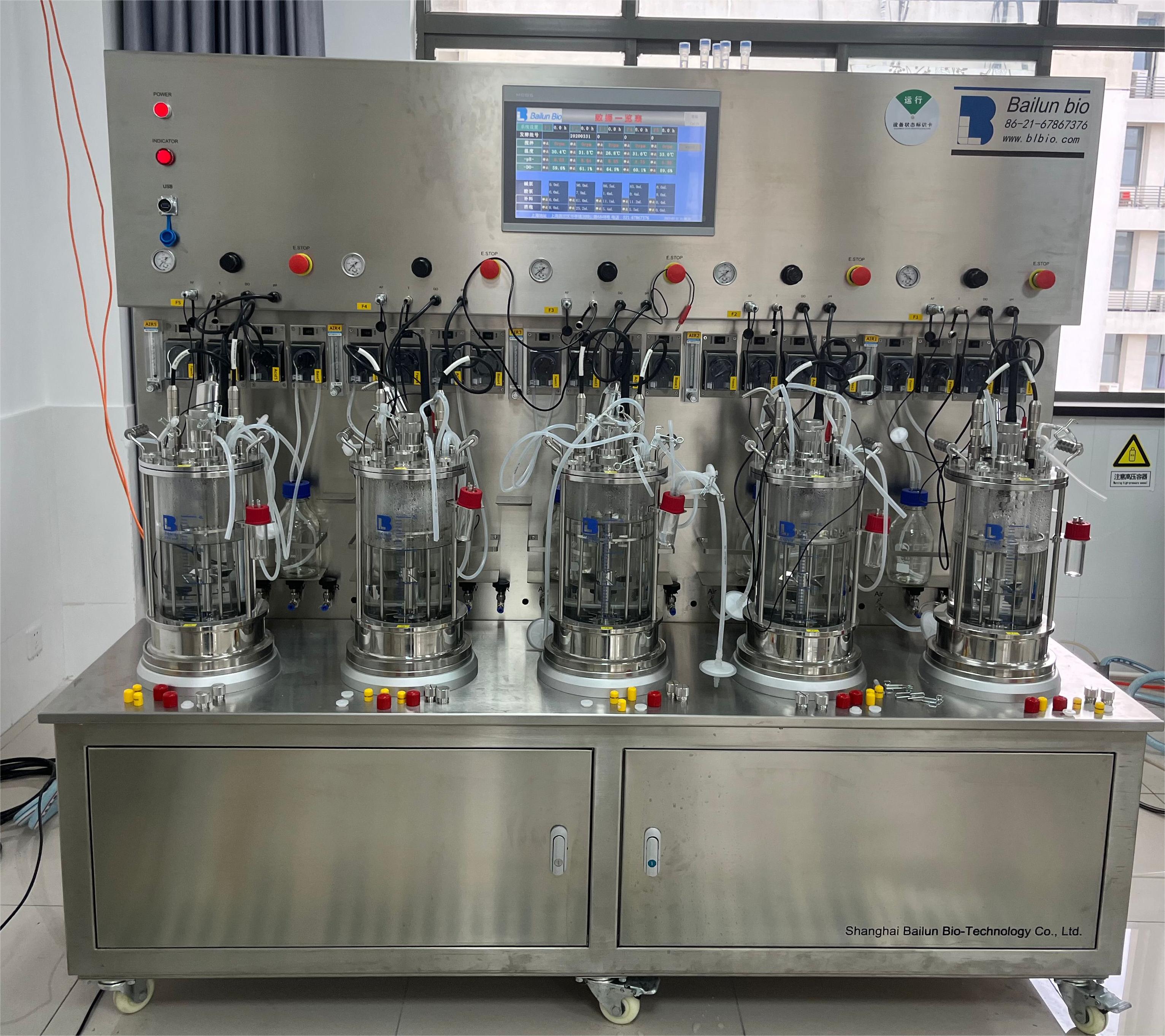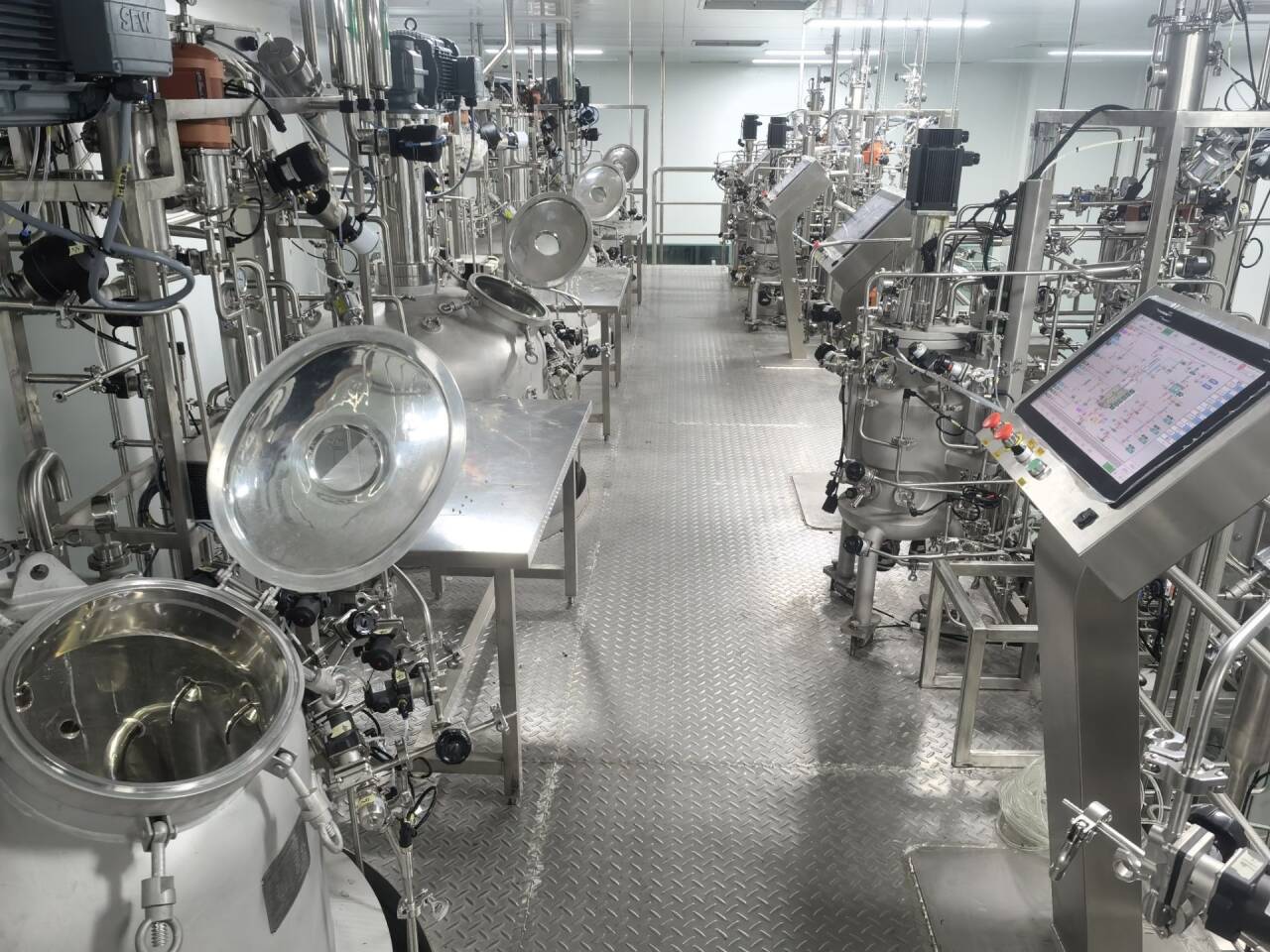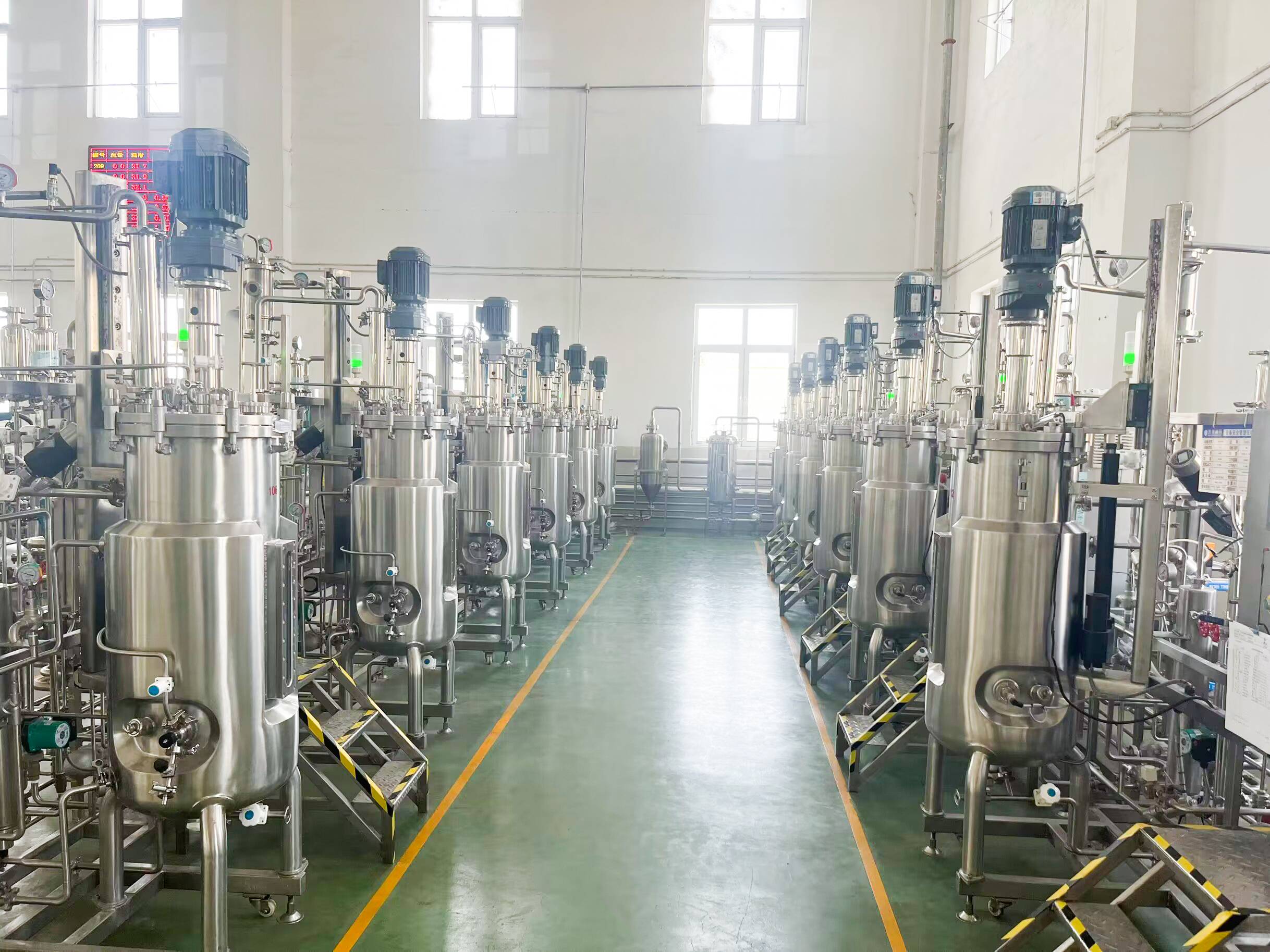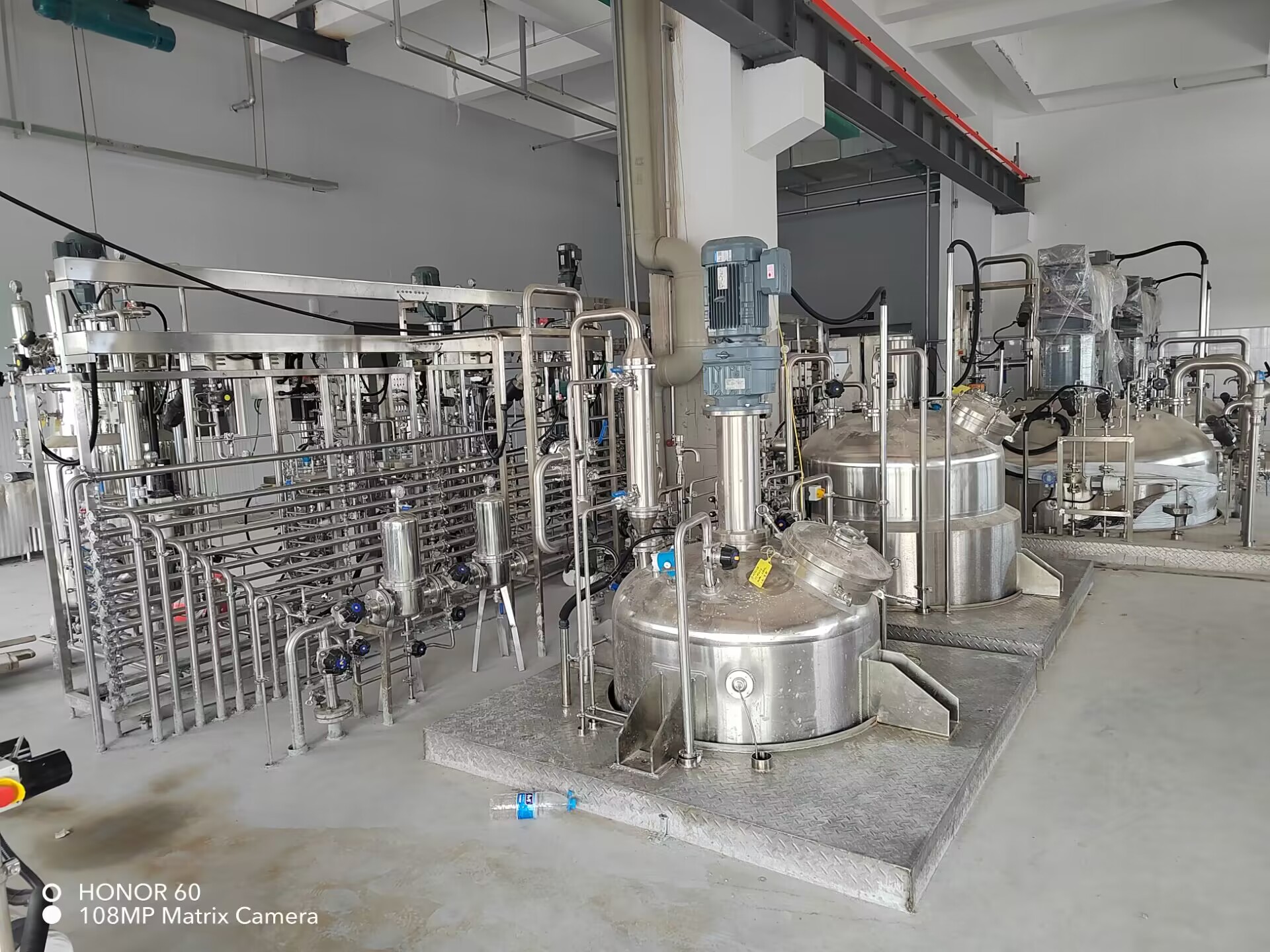Fermenter/Bioreactor
- Mini Glass Fermenter
- Lab and Pilot Scale Fermenter
- Pilot and Production Scale Fermenter
- Multi Stage Stainless Steel Fermenter
- Magnetic Stirring Fermenter
- Solid State Fermenter
- Enzyme Bioreactor
- Cell Culture Fermenter
- Vaccine Production Fermenter
- Inactivation Tank
- Mixing Tank Ingredients Tank
- Airlift Fermenter
- Spray Dryer
- Glass Bioreactor
- Multistage Glass Fermenter
- Light(photo) Fermenter
- Centrifuge
- blog
General Info
The biopharmaceutical industry is at a crossroads, with the need to meet growing medical demand and sustainability pressures. Traditional chemical synthesis struggles to make complex molecules efficiently and sustainably. Biosynthesis, on the other hand, offers better options. In Biosynthesis scientists use the power of living organisms to make biopharmaceuticals with more precision, purity and scale. This reduces environmental impact and increases production quality and reliability. And as the industry adopts biosynthesis it’s opening up new healthcare innovations and more sustainable manufacturing. In this article, we will look at how biosynthesis is fixing long standing inefficiencies of biopharmaceutical industry and driving the next wave of innovation.
Problems with Traditional Chemical Synthesis
Before we get into Biosynthesis and its applications, let’s look at the issues with traditional chemical synthesis. These traditional methods have big environmental and operational problems:
1. High Energy Demand: Many chemical synthesis processes require high energy conditions, high temperatures and pressures. This high energy consumption adds to the cost of production and the industry’s carbon footprint. As the world is going green these energy hungry methods are a big barrier to green production.
2. Toxic Waste Generation: Another issue with chemical synthesis is the generation of toxic by-products which are hard to manage. Treating and disposing of these substances requires complex waste management systems, adds to operational costs and regulatory complexity. Long term environmental impact of unmanaged waste can be catastrophic to ecosystems.
3. Dependence on Non Renewable Resources: Traditional chemical synthesis is heavily dependent on fossil fuels, depleting resources and adding to greenhouse gas emissions. The finite nature of these resources creates supply chain uncertainty and rising costs, while extraction processes pollute air and water. It’s unsustainable.
In addressing these challenges, biosynthesis emerges as a highly promising and sustainable solution for the production of complex biomolecules.

What is Biosynthesis?
Biosynthesis is a natural process that converts simple substances into higher molecular forms. All living organisms, from bacteria to human beings use this process to synthesize the basis of life. Apart from its biological significance, biosynthesis has attracted interest from industries such as pharmaceutical, agriculture and energy. This is because biosynthesis is known to be friendly to the environment as compared to the traditional chemical synthesis. A few of its benefits include:
● Renewable Resources: One of the main advantages of using Biosynthesis is that it utilizes Bio resources such as agricultural products and mass biomass. By using renewable resources, Biosynthesis reduces our dependence on fossil fuels and and turns waste into valuable products.
● Less Energy: Biosynthesis works under comparatively mild conditions as opposed to chemical syntheses. Most biosynthetic reactions occur at normal temperature and pressure hence cutting on energy costs. It minimises cost of production and the use of natural resources in compliance with sustainable manufacturing.
● Minimal Waste: The other advantage of Biosynthesis is that it generates fewer by-products as compared to chemical synthesis. The conventional chemical synthesis method generates a large amount of waste that cannot be easily dealt with and pollutes the environment.
Biosynthesis represents a shift in pharma and will solve health issues as biotechnology progresses. Chemists can now create new drugs and do not need to use the chemical synthesis method that has been used in the past.
Modern Biosynthetic Technologies
Biosynthesis has come a long way in the last few decades with advances in genetic engineering, bioinformatics and process optimisation. Modern biosynthetic technologies are at the forefront of biopharmaceutical innovation, allowing the precise production of complex molecules that were impossible to make at scale. These technologies are key to overcoming the limitations of traditional chemical synthesis and the growing demand for safe, effective, and sustainable biopharmaceuticals. A few of modern biosynthetic technologies include:
1). Advanced Expression Systems
Expression systems are the foundation of Biosynthesis, providing the cellular machinery to produce the target molecule. Modern advances have expanded the range of expression systems, each for specific biopharmaceutical applications. A few of these include:
● Bacterial Systems: Escherichia coli is the most frequently used bacterial host and is invaluable for the synthesis of basic proteins. They bring fast growth returns, high yield, and cheap production base. Nevertheless, its incapability of carrying out multiple types of post-translational modifications such as glycosylation makes it less suitable for more complicated biomolecules.
● Mammalian Cell Culture: For formation of complex proteins and monoclonal antibodies, mammalian cells especially Chinese Hamster Ovary (CHO) cells are used. These cells are able to fold proteins, glycosylate and perform other processing on proteins that are needed in therapeutic applications for humans. They are the preferred choice for high value biopharmaceuticals such as monoclonal antibodies, recombinant hormones and so on.
● Yeast Systems: Bacterial systems are less complex than yeast expression systems like the Saccharomyces cerevisiae although more complex than the mammalian systems. Yeast is suitable for vaccines, enzymes, and hormones. It’s flexible in terms of scale and can only do a bit of glycosylation so it is a versatile biosynthesis method.

2). Genome Editing & Synthetic Biology
Recent advances in genome editing technologies like CRISPR-Cas9 have changed the game for Biosynthesis by allowing precise modification of the genetic code of organisms. Synthetic biology takes it a step further by designing entirely new biological pathways to produce new molecules.
For example: Microbes can now synthesise rare natural products like artemisinin, an antimalarial drug, at industrial scale. Synthetic pathways are being developed to produce bio-identical human milk oligosaccharides which are essential for infant nutrition. These advancements enable more products to be biosynthesized more efficiently, making Biosynthesis viable for diverse applications.
3). Process Optimization techniques
Modern biosynthetic processes are all about optimizing to get more yield and reduce cost and consistency. Here are some key techniques:
● Metabolic Flux Analysis: By mapping out the metabolic pathways of the host organism, scientists can identify bottlenecks and boost cellular productivity. This has been used to improve Biosynthesis in microbial systems.
● Genomic Integration: Strategic integration of synthetic genes into the host genome ensures stable and high expression. This reduces variability and scales better in large bioreactor systems.
● Media Optimization: Customising nutrient rich media for the biosynthetic organisms boosts productivity and reduces time to production. For example, custom media for CHO cells has given 2x monoclonal antibody yield in biopharmaceutical production.
4). High-throughput screening and Automation
Automation and high-throughput screening have sped up biosynthetic tech development.
Robotic platforms can test thousands of genetic and process variables at once, identifying optimal conditions for production. These systems reduce development time and human error and are reproducible and scalable. High-throughput screening was key to optimizing the biosynthetic pathways for mRNA vaccine development during the COVID-19 pandemic.
5). Integration with Data-Driven Technologies
Biosynthetic processes are using modern data-driven technologies like machine learning and AI. These tools look at the massive data generated during Biosynthesis and give real-time feedback. AI algorithms can predict the synthetic pathway, find problems and suggest fixes before production is impacted.
Modern biosynthetic technologies are changing the pharmaceutical horizon by solving long standing problems. From advanced expression systems to data driven process optimisation these technologies are enabling safer, more effective and sustainable biopharmaceuticals. Their continued evolution will expand the boundaries of what is possible in medicine and bring about a new era of precision and possibility.

Medical Breakthroughs Made Possible by Biosynthesis
Biosynthesis has brought about tremendous progress in the biopharmaceutical industry and treatments that were previously impossible. Here are some of the game-changers:
1. Monoclonal Antibodies (mAbs)
Monoclonal antibodies, engineered proteins that target specific antigens, have transformed treatments for cancer, autoimmune disorders, and infectious diseases.
Biosynthesis allows:
● Precision production, less impurities.
● Customizable antibody structures for better efficacy.
● Scalability with bioreactors for global markets.
For example, Rituximab, used in lymphoma treatment, is produced through Biosynthesis in mammalian cell bioreactors.
2. Recombinant Insulin Production
Traditional insulin extraction from animal pancreas was laborious and limited in scale. Biosynthesis changed that by introducing recombinant DNA technology, and now microorganisms like E. coli can produce human insulin.
● Cost-effective: Lower production costs than animal-derived insulin.
● Patient-friendly: No animal impurities.
This process uses fermenters and bioreactors to grow microbial cells in optimal conditions for high yield and purity.
3. Vaccine Development
Vaccines are essential to the global health system, and Biosynthesis has been quite beneficial. Biosynthetic can help with:
● Crisis intervention for new illness, like Corona virus or Covid -19.
● Higher scale production through bioreactors. For example, in the development of mRNA vaccines, Biosynthesis is used for the synthesis of both lipid nanoparticles, and mRNA.
Table 1: Examples of Vaccines Produced Using Biosynthesis
Vaccine Type | Biosynthetic Method Used | Application |
mRNA vaccines | Biosynthetic lipid & RNA production | COVID-19 |
Protein subunit vaccines | Recombinant protein synthesis | Hepatitis B, HPV |
Conjugate vaccines | Polysaccharide-protein linkage | Meningococcal, Haemophilus influenza |
Critical Parameters & Control Systems
Biosynthesis is a lengthy biochemical process that needs careful adjustment of a number of factors relating to the environment and operation in order to achieve maximum output. All of them have significant impact for cell viability, enzyme activity, and product quality. Below are the key parameters and their impact on biosynthesis:
Parameter | Typical Range | Impact on Production |
Temperature | 30-37°C | Influences cell growth, protein folding, and enzyme stability. |
pH | 6.8-7.4 | Affects enzyme activity, cell viability, and metabolic rates. |
Dissolved Oxygen | 30-60% saturation | Essential for cellular respiration and metabolic activity. |
Agitation | 50-200 rpm | Ensures proper mixing, nutrient distribution, and suspension of cells. |
Maintaining these parameters within the acceptable range requires advanced control systems as even small deviations can result in significant loss of product yield or quality. For example, incorrect pH levels can denature proteins or inhibit enzyme functions, while low oxygen saturation can slow down metabolic processes.
In order to maintain such control, bioreactors have well developed feedback and control mechanisms which allow for changes to be made in real time. These technologies help to maintain environmental conditions are at their optimal specified state for biosynthesis to occur.

Bioreactor Technology Advancements Driving Biosynthesis
Biosynthesis in Medicine requires advanced bioreactors to grow living organisms and produce complex biomolecules in a precise and controlled environment. Bioreactor technology has improved efficiency, scalability and product quality. Here’s how.
1. Control for Perfect Conditions
Modern bioreactors have control systems that can control temperature, pH, oxygen levels and agitation speed with precision. This means perfect conditions for biological systems to grow and produce what you want.
● Real-time monitoring and automation to prevent deviations in critical parameters for product consistency and quality.
● For monoclonal antibody production even small variations in growth conditions can impact yield, potency and efficacy so control is key.
In smaller scale R&D settings laboratory glass bioreactors are the perfect platform to optimize parameters before scaling up to industrial production. These tools allow you to find the perfect conditions for biosynthetic processes without compromising reproducibility.
2. Single-Use Bioreactors (SUBs)
Single-use bioreactors (SUBs) have revolutionized biomanufacturing by offering flexibility and simplicity. They’re perfect for biosynthesis in multi-product facilities or facilities focused on personalized medicine. Key benefits of SUBs are:
● Less contamination risk: Disposable components mean no cleaning protocols and reduced cross contamination risk.
● Lower costs: No cleaning and sterilization steps means less water and chemicals used, lower operational costs and environmental impact.
● Faster changeovers: Quick turnaround between runs means more agile manufacturing for pharma’s dynamic requirements.
Single-use bioreactors are most valuable in vaccine and therapeutic protein production where flexibility and speed is key to meet public health needs.
3. Photobioreactors for Specific Applications
Photobioreactors are a type of bioreactor that use light as an energy source to grow photosynthetic organisms like algae. They produce compounds like beta-carotene, omega-3 fatty acids and certain biopharmaceutical precursors.
Photobioreactors offer:
● Scalability: Photobioreactors deliver results across all scales.
● Fast delivery: Advanced design means evenly distributed, maximum productivity.
● Energy efficiency: High efficiency lighting systems use less energy while maintaining output.
Applications in biosynthesis are vaccine components, vitamins and other bioactive molecules, so they are versatile in pharmaceutical manufacturing.
Control Systems and Bioreactor Design Synergy
The combination of precise control systems and advanced bioreactor design is the key to modern biosynthesis. Together they deliver:
● Higher yields: By controlling parameters bioreactors optimise cell growth and product formation.
● Repeatability: Automated systems give consistent results across multiple batches, critical in pharmaceutical manufacturing.
● Sustainability: Energy efficient design and single use technology reduces waste and environmental impact.
By combining these technologies biosynthesis can meet the growing demand for complex biopharmaceuticals, safer, more effective and sustainable solutions for global health.
Wrapping up
In summary, biosynthesis is changing medicine by enabling efficient, sustainable and precise production of complex biopharmaceuticals. From monoclonal antibodies to mRNA vaccines — biosynthesis is at the core of the innovation, addressing the limitations of chemical synthesis. And BaiLun Biotechnology is part of this revolution with its bioreactor technology. Whether it’s the precision of lab scale glass bioreactors, the scalability of industrial fermenters or the flexibility of single use systems, BaiLun bioreactors provide the perfect environment for cell growth and metabolism, higher yields and better product quality while being sustainable. Partner with BaiLun Biotechnology and get the latest technology to meet your industry needs. Contact us here.
